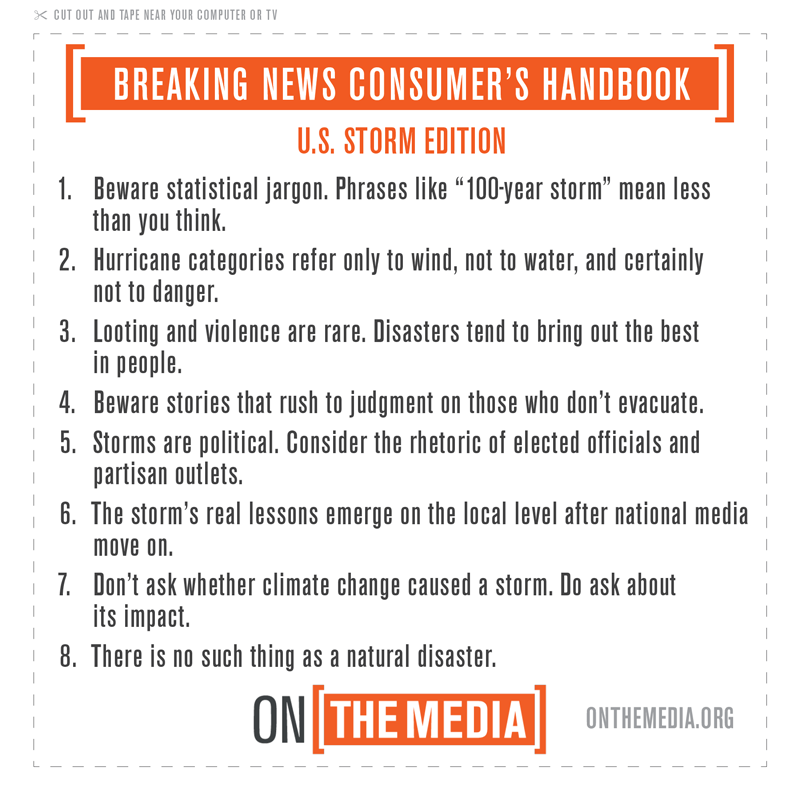With Hurricane Irma barreling through the Caribbean toward South Florida, people across the U.S. (including here at Poynter, which was evacuated last night) are getting a little jumpy. And with the heightened anxiety has come an influx of fake news about the storm.
In the past few days, several Irma-related hoaxes have been circulating online. From fake forecast projections showing the storm heading toward Hurricane Harvey-stricken Houston, to old videos of tornadoes republished under the guise of hurricane winds, there’s been no shortage of misinformation — and Irma is still at least 36 hours away from making landfall in the U.S.
It seems the latest batch of fake news and photoshopped weather projections takes a page from the misinformation circulated during the aftermath of Harvey last week. That included a viral photo of a shark swimming in the floodwaters on a Houston freeway — which was also photoshopped into scenes from hurricanes Matthew and Sandy — and a tweet that falsely claimed former president Barack Obama was serving food to evacuees (h/t to The Washington Post’s Abby Ohlheiser for compiling running lists of hoaxes for both storms).
In general, natural disasters are ripe times for fake news to go viral online. Claire Wardle, executive director of First Draft, told The Verge late last month that misinformation spreads rapidly during hurricanes because more people are turning to social media to follow the story, making it more likely that they share a sensational photo or headline. But just because there’s another hurricane doesn’t mean you have to fall victim to spreading fake news.
Here are seven tips to avoid sharing misinformation about Irma online. Read them before publishing that sensational Facebook or Twitter post.
1. Get your weather information from the National Hurricane Center and the National Weather Service
Perusing news from your friends on Facebook or Twitter is an easy way to monitor Irma and its aftermath, and news organizations offer great insight and coverage of the storm. But if you want to have the latest and most accurate weather information, then you need to narrow down your sources to the tried and true.
“On Twitter, you have to be very careful where you get your information from,” said Phil Klotzbach, a research scientist in the Department of Atmospheric Science at Colorado State University. “In general, most consumers don’t know what they’re looking at.”
Klotzbach said he gets all of his updates about hurricanes from the National Hurricane Center, a division of the National Weather Service that publishes updated forecasts and projection models at regular intervals both online and on social media. The NWS itself is another good source for up-to-date hurricane maps and evacuation notices — do yourself and follow both on social media so you don’t miss a thing.
“There’s a reason they pay those guys at the Hurricane Center,” Klotzbach said. “They don’t hype stuff up.”
Keep your eyes out for fake forecasts. THIS is what an official NOAA advisory looks like. Note: forecast only goes out 5 days. #Irma pic.twitter.com/9k87y7jkMz
— NWS (@NWS) September 1, 2017
2. Know a few basic facts about hurricanes
Over the past few days, there have been false reports that Irma may be upgraded to a Category 6 hurricane due to its strength. There’s just one problem with that — that classification doesn’t exist.
“There’s only Category 5, no matter how strong the storm is,” Klotzbach said.
There are several other facts about hurricanes to know when following Irma. First, the point of a cone map isn’t where the center of the storm will be, just where it’s most probable at the time. Everything within the cone represents where the center of the storm could go based on forecast errors over the past five years, not how big the storm is. Second, the NHS will never definitively say what the path of a storm is more than a few days out. Third, categories don’t necessarily denote the level of a danger a hurricane has, just the speed of the winds it carries with it.
Impacts can occur outside the cone. Learn what it tells you & doesn’t tell you. For the latest forecast cone https://t.co/meemB5d6ch #Irma pic.twitter.com/15ASDnXMHc
— NWS (@NWS) September 8, 2017
That’s by no means an exhaustive list, but keeping those facts in mind in the coming days might spare you from sharing fake news or misinformation about the hurricane.
3. Don’t believe everything a spaghetti plot shows you
We’ve all seen them countless times this week: messy maps of the Caribbean with thin, colored lines extending out and up toward the Florida peninsula. But what do they mean?
It depends, but usually not much.
On Wednesday, Eric Berger published a piece for Ars Technica criticizing a South Florida Water Management District spaghetti plot Nate Silver shared that showed the potential routes Irma could take around Florida. The key problem with that lies in the data sources used to draw the lines.
“Spaghetti plots are not good decision-making tools,” Berger wrote. “To the untrained eye, all models are created equal, when they most certainly are not.”
Still some uncertainty in the Hurricane Irma forecast but more and more projections are converging on Florida. https://t.co/Tk8G06vz0g pic.twitter.com/ADFYTHTsdG
— Nate Silver (@NateSilver538) September 6, 2017
While some of the plot's data sources were useful, some of them were out of date by 12 hours or simply unrelated to tracking a storm’s path through the Atlantic. When assessing hurricane projections online, make sure they’re coming directly from data provided by the NHC.
“Nate Silver is a really smart guy, but he’s not a weather guy,” Klotzbach said. “You have to be very careful when you look at models.”
4. Use reverse Google Image Search
This is a classic and easy one — and among the fastest ways to debunk a viral image.
If you see an image on social media that seems too wild to be true, such as a shark swimming on a freeway in a major city, take a second to double-check its validity. If you’re using Chrome, simply right click on the photo and select “Search Google for Image,” then see where else it has been published.
Two other useful tools you can use to double-check a photo include RevEye and TinEye. The former is a Chrome plugin that allows you to search multiple engines at once, while the latter is a search similar to Google's. If a photo is widely cited for a different event, or if a fact-checker has already debunked it, hold off on sharing — your followers will thank you.
5. Be wary of claims that this is a record-setting storm
Is Hurricane Irma an enormous, historic, potentially catastrophic storm? Absolutely, Klotzbach said. But is it the worst one ever recorded?
“That’s not true,” he said. “Whenever someone says it’s the ‘something something ever,’ that’s something to watch out for. You have to really know what you’re looking at.”
It’s true that Irma is one of the strongest hurricanes ever recorded in the Atlantic Ocean, but it’s also important for people to realize that the storm is at least 36 hours from arriving in South Florida — and there’s still so much even meteorologists don’t know, Klotzbach said. While people should take the hurricane seriously, he said they should also steer clear of those looking to incite panic.
“This is a very serious storm. This is not one to think they’re overhyping it,” he said. “Just be really careful of people who are overly confident.”
6. Don’t assume everyone in the path of the storm needs to evacuate
A common misconception during big hurricanes is that people who stayed behind ignored evacuation orders, and they’re often judged for doing so. But not everyone in the path of a storm needs to leave — especially just because of its category.
“Categories don’t matter when it comes to evacuations,” Klotzbach said. “If you need to leave, you need to leave. Categories are only based on maximum sustained winds.”
It’s important for people in the path of Irma to listen to their local officials to know when and whether or not to evacuate instead of media outlets and friends, he said. They can go to their official county website to see if they're under an evacuation order.
For those outside the storm path, keep in mind that evacuations are based on a myriad of things, from the elevation and flood risk of an area, to the mobility and needs of those who live there. Whatever you do, don’t be this guy.
7. Watch out for false narratives, jargon and rushes to judgment
This one comes from last week’s episode of WNYC’s On the Media. The podcast discussed some of the things journalists get wrong when covering storms like Hurricane Harvey, and how to fix them.
“(Hurricane coverage) doesn’t seem hard to understand, but in fact it is,” Host Brooke Gladstone opens the show.
Some of the important points made during the podcast include the importance of avoiding statistical jargon like “100-year storm,” remembering that looting and violence are rare in the aftermath of hurricanes and recognizing that all storms are inherently political.
OTM also published a new version of its lauded breaking news handbook, this time for U.S. storms. While it’s catered to journalists, it provides a good framework for news consumers to use when trying to interpret news about Hurricane Irma and future storms.

Above all, keep one thing in mind when following Hurricane Irma. “Don’t try to be too much of your own meteorologist,” Klotzbach said. “It’s just an uncertain science.”









